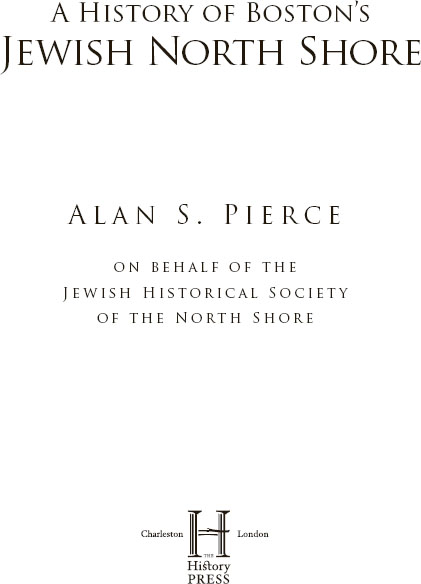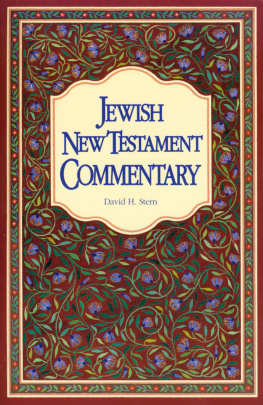

Published by The History Press
Charleston, SC 29403
www.historypress.net
Copyright 2009 by Alan S. Pierce

All rights reserved
Front cover images: Top: A jubilant groom breaks the ceremonial glass after exchanging vows. Courtesy of Harold Summers Photography.
Bottom: The Great Shofar Blowout. Courtesy of Herb Goldberg.
First published 2009
e-book edition 2013
Manufactured in the United States
ISBN 978.1.62584.280.0
Library of Congress Cataloging-in-Publication Data
Pierce, Alan S.
A history of Bostons Jewish North Shore / Alan S. Pierce.
p. cm.
print edition ISBN 978-1-59629-658-9
1. Jews--Massachusetts--Boston Region--History--20th century. 2. Jews--Massachusetts--Boston Region--History--21st century. 3. Jews--Massachusetts--Lynn--History. 4. Jews--Massachusetts--Swampscott--History. 5. Jews--Massachusetts--Peabody--History. 6. Jews--Massachusetts--Salem--History. 7. Jews--Massachusetts--Beverly--History. 8. Massacusetts--Ethnic relations. I. Title.
F73.9.J5P54 2009
974.45--dc22
2009015722
Notice: The information in this book is true and complete to the best of our knowledge. It is offered without guarantee on the part of the author or The History Press. The author and The History Press disclaim all liability in connection with the use of this book.
All rights reserved. No part of this book may be reproduced or transmitted in any form whatsoever without prior written permission from the publisher except in the case of brief quotations embodied in critical articles and reviews.
Ldor Vdor
From Generation to Generation
This book is lovingly dedicated and was expressly prepared for our children and our childrens children.
CONTENTS
INTRODUCTION

The photographs are faded, the names are long forgotten; streets and buildings that once echoed with the sounds of life have vanished. It is easy to forget the past, easier still to ignore the simple fact that one day the fabric of our lives, our work, our dreams will become the threads of some distant history. But these are reasons to remember because somewhere amidst the fading images, forgotten names, vanishing streets, we find ourselves. And though it is easy to forget, we remember. Because in this book, a portrait of our community, we remind ourselves of not only who we were, but who we are.
Steve Cohen in Reasons to Remember, a documentary produced by the Lynn Arts Council and the Jewish Historical Society of the North Shore
The Jewish Historical Society of the North Shore (JHSNS) was founded in 1977 with a mission to collect, preserve and display the tangible evidence of the Jewish presence on the North Shore of Boston. For over thirty years, JHSNS has strived to serve our community as a link to the past and a precious resource for future generations. We hope that this book serves to further that mission in an effective way.
Alan Pierce, president of the Jewish Historical Society of the North Shore, originated the idea of a new history of the North Shores Jewish communities, one that would include more text than the societys previous publication, first published in 2003. He took the lead in organizing the committee, delegating the research, authoring some of the sections and cheering everyone on. Society members Edye Comins Baker, Helaine Roos Hazlett, Judy Simon Remis, Judy Axelrod Arnold, Ruth Kemelman Rooks and Elaine Hillson Federman researched and authored all or parts of the chapters. Barbara Tolpin Vinick was the overall editor.
Chapters cover the cities of Lynn, Peabody, Salem and Beverly and the towns of Swampscott and Marblehead. These cities and towns comprise, for the most part, the archives of JHSNS. The book is a compilation of the histories of these communities from several sourcesprincipally from the archives of JHSNS but also from material generously made available by the Jewish Journal Boston North and the many Jewish institutions that continue to serve the community spiritually and culturally. With over a century of Jewish life to cover with limited time and pages, we tried to mention as many people, businesses and Jewish institutions, past and present, as possible in order to capture the essence of our rich Jewish history. We realize, however, that although our intentions were to be inclusive, we may have left out some important elements of that history. Please forgive our lapses.
Over a century ago, Jews, primarily from eastern Europe, arrived in the major North Shore cities of Lynn, Peabody, Salem and Beverly. This led to the rapid development of urban Jewish neighborhoods and their sustaining institutionssynagogues and mutual aid societies. There soon followed Hebrew schools and community centers. These cohesive communities flourished through the first half of the twentieth century. After World War II, however, with postwar prosperity and the assimilation of second- and third-generation Jews, movement out of traditional Jewish neighborhoods was widespread. Many of Lynns Jews moved to neighboring Swampscott and Marblehead. Rural farmlands of West Peabody gave rise to suburban subdivisions attracting Jews from downtown Peabody, as well as from the other Jewish strongholds of Chelsea, Revere, Winthrop, Malden and Everett.
Demographic shifts had a profound effect on the synagogues and community centers that had served the older cities so well. In the 1960s, the Lynn Jewish Community Center on Market Street relocated to Marblehead. Peabodys Hebrew Community Center closed in the early 1970s and was replaced by the North Suburban JCC in West Peabody. Shuls closed and newer, more modern temples were built in Marblehead, Swampscott and West Peabody. Beverly and Salem, in the latter half of the twentieth century, saw a decline in Jewish population with movement to outlying towns of Middleton, Danvers, Ipswich and Boxford, where land was less expensive and bigger homes could be built.
Today, demographic and social changes continue to place increasing tension on the institutions that have supported the Jewish community so well for so long. In Swampscott, Temple Israel and Temple Beth El merged into Congregation Shirat Hayam in 2005. Other synagogues are faced with the challenges of diminishing membership, aging buildings and a population base more spread outfactors leading to the necessity of creative approaches to maintaining a sense of Jewish community. One thing seems clear: the twenty-first century will continue to challenge the areas Jews, as our ancestors were challenged over one hundred years ago. This book allows us to see and celebrate who we were and to inspire us to maintain our Jewish community. In all important ways, it is who we are.
LYNN
The city of Lynn, incorporated in 1631, is located thirteen miles north of Boston, along the coast. Long known as a major center of shoe manufacturing, Lynn fell into economic decline in the 1970s. Many of its Jewish neighborhoods have been replaced by neighborhoods of new immigrants with Hispanic and Southeast Asian roots. This chapter focuses on Jewish life in Lynn and the Jews in Lynns shoe trade.
THE JEWS IN LYNN, A RETROSPECTIVE
Based on a 1986 monograph by the late Nathan Gass
Next page













